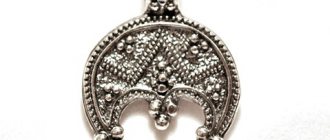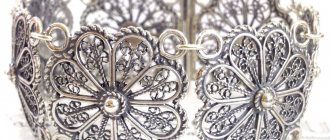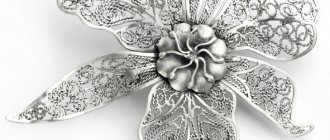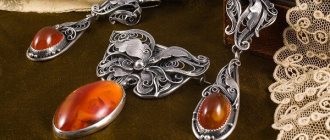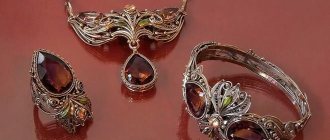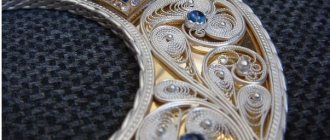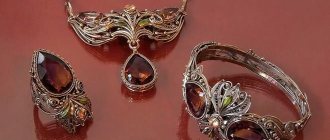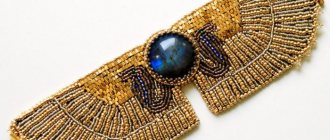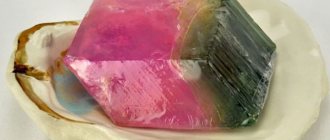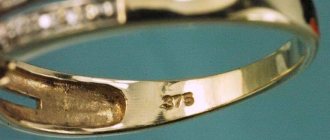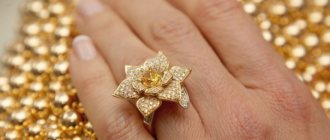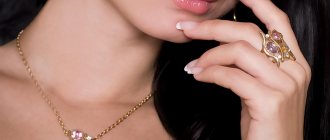Types of jewelry filigree
Depending on the technique used to create the work of art, there are several types of filigree.
Brazed filigree
This type of filigree was popular in medieval Europe. The method involves soldering a silver thread onto a previously prepared metal plate.
If the plate remains in the finished product, then this type is called background or “blank”. In some cases, the background is sawed out, resulting in a cut-out filigree.
Openwork filigree
The main feature of openwork filigree is the absence of a background. A pattern is assembled from silver threads soldered together. The grain is soldered onto the wire. If it is not in the product, then it is called flat lace.
Two- and three-dimensional volumetric filigree patterns are called sculptural-relief filigree.
Volumetric filigree
Separately, we should highlight products made using the volumetric filigree technique. Often, such filigree takes the form of household items, dishes, figurines of birds and animals.
Due to the increased complexity of the product, individual filigree elements are first created, which are then combined into one whole.
Interesting! In jewelry production, you can find all three filigree techniques, depending on the type of product.
Production technologies
Types and elements of filigree
There are openwork and background or soldered filigree. Openwork filigree is a kind of lace pattern with a pattern visible through it. Filigree soldered onto a specially prepared background, solid (solid filigree) or filigree (openwork), is called background. Both openwork and background filigree can be flat and voluminous. An example of openwork filigree can be flat brooches, an example of background filigree can be pendants, earrings of conical and cylindrical shapes.
Rice.
1. Elements of filigree Elements of openwork and background filigree are very diverse and numerous in shape, size, name (Fig. 1).
Surface
— round wire of various (specified) lengths and cross-section from 0.2 to 1.3 mm; wire flattened on the sides is called flat satin.
Rope
- a flagellum twisted from two wires of any cross-section, often rolled (flat rope); The granular surface formed on the edges of a flat rope allows you to create the effect of a particularly beautiful granular pattern in decoration.
Cord
(lace) - an element twisted from two, three, four wires or two ropes, or ropes and wire.
Network
- a kind of braid woven from three or more wires; part is used as a side rim of flat filigree decorations.
Herringbone
- two adjacent ropes with a spiral directed in different directions, with a slight or complex bend.
A round track is a slightly stretched spiral of round smooth surface of small cross-section; often used to highlight individual ornaments from the overall pattern.
Crumpled and flattened path
- an element in the form of a tumbled or flattened spiral, the rings of which, leaning on one another, partially cover each other.
Zigzag path
- this is a jagged track made of flat surface, round and flat rope or a snake made of flat or round rope; used as intermediate elements of openwork filigree, as well as in the manufacture of background filigree with an openwork background.
Grain
- small metal balls.
ring
- a ring made of flat and round satin stitch, round or flat rope; used primarily for setting background filigree and as an integral part of other elements.
Half ring
- part of the ring; used as an independent element for setting the background filigree and as an integral part of other elements.
Burdock
- an element made of a flat or round rope or flat satin stitch of small cross-section in the form of a ring, framed around the circumference by four half-rings.
Star
- the same as burdock, but with a large number of half-rings, from 5 to 8.
cucumber
- a cucumber-shaped element made of flat or round rope.
Grushechka
- an element shaped like a drop, made of flat or round rope.
clove
- an element bent from a flat or round rope in the form of the outline of a saw tooth or gear.
Developmental girl
- the same as a clove, but with the ends bent outward.
Petal
- made of flat or round rope or flat satin stitch, an element in the form of a daisy petal.
Tee
- trefoil made from flat or round rope or flat satin stitch.
little head
- an element in the form of an inverted comma, made from a flat, or less often from a round rope.
Grass
- made of flat satin stitch or flat round rope, a “teeth” with elongated tendrils curling in one direction in a flat spiral.
Curl
- an element in the form of a bow with the ends bent inward to form rings, made from flat satin stitch, flat or round rope.
leaf
- from a flat rope, a flat leaf-shaped spiral, crumpled from the sides.
Perm
- a trefoil, welded from three leaves of different shapes.
bug
— a ring made of a round track (spiral) with grain in the center.
Socket -
a spiral ring of crumpled track turned into a spherical concave cup with grain inside.
How is filigree jewelry made?
Elements of a filigree pattern are rope, cord, weaving, herringbone, track, satin stitch, and so on. It is essentially a lace appliqué made from metallic thread. Filigree is often combined with granulation - small balls that are soldered into prepared cells (recesses). The grain gives filigree a particularly elegant, sophisticated look. The materials for the products are alloys of gold, silver and platinum, as well as copper, brass, cupronickel, and nickel silver. The filigree technique can be used to make all types of jewelry without exception.
Who owns the filigree technique: historical background
It is believed that the first masters who mastered this interesting technique appeared in Ancient Egypt and ancient Greece. The oldest items discovered during excavations of ancient cities date back to the 6th century BC.
The rapid growth in popularity of filigree products was noted in the 18th century.
European craftsmen created unique jewelry for wealthy citizens and nobles. The 19th century is rightfully considered the heyday of filigree crafts. At this time, jewelry began to be mass produced and was available to almost all classes.
Russian filigree originates in ancient centuries. Filigree in Ancient Rus' was primarily a ritual item, which then migrated to the princesses’ boxes.
The famous Krasnoselskaya filigree created a worldwide sensation at the Paris Exhibition in 1937. Success was repeated 2 years later in New York.
Varieties of filigree
There are many ways to vary the filigree technique: using enamel and precious stones, applying wire patterns to niello, or a combination of filigree techniques.
In total, there are 3 main types of this jewelry art:
- Soldered filigree. This is a jewelry making technique in which a wire pattern is soldered onto a metal base sheet. It is very often combined with enamel and differs in type into background (blank) filigree, perforated (cut) filigree, cloisonné enamel and others.
- Openwork filigree. The openwork technique involves fastening wire patterns without soldering them to any base. Creating metal lace requires extensive experience in working with metals and care when soldering. When adding grain to the technique, metal balls are soldered onto the lace elements.
- Volumetric scan. To make voluminous filigree jewelry, a step-by-step approach is used: several components, made using the openwork filigree technique, are combined together into a single composition.
The filigree technique of precious metals can create colorful combinations with various materials: precious and semi-precious stones, enamel, blackened silver, glass and wood.
The variety of different inserts into filigree ornaments required a high level of skill in working with metals. For example, to complement the decoration with niello, it was necessary to sprinkle an alloy of several metals on the product and fire it so that the molten niello filled the relief pattern.
Initially, filigree masters preferred exclusively precious metals like gold and silver, giving preference to the former due to several of its features:
- First of all, gold is a very fusible metal, that is, heating it to a state of “ductility” requires a temperature that will be much lower than the melting point of steel or iron.
- Gold is an extremely ductile material. With a high degree of purity, it is easily deformed even without heating.
- Gold is a fairly economical material. This means that from a relatively small amount of this metal it is possible to pull out an impressive length of gold wire, from which filigree patterns are made: rings, bends and curls.
- This noble metal has been highly valued throughout human history. The wealthiest members of the communities decorated themselves with gold items, the manufacturing techniques of which only became more complex over time. Filigree ornaments made of gold adorned icon frames, basmas and earrings.
Russian craft
Filigree in Ancient Rus' is a kind of calling card of original Russian jewelry art. This technique was widely used to make not only jewelry, but also church utensils, frames for sacred books and icons, weapons, and household items. For example, even morocco boots were decorated with filigree.
In the 17th century, special workshops were opened in Rus' in which they were engaged in the manufacture of wire (drawing). And at the monasteries, in the princely estates, workshops were opened in which real talents of filigree work worked. Chronicle sources name Ivan Fomin and Ambrose as the most famous masters of those times.
Filigree are very expensive products that were available only to rich people. After all, it was delicate manual work, requiring the master to have accumulated years of experience, which contained the secrets of mastery.
Filigree or filigree?
Essentially, these two words mean the same thing.
Only the first - originally Russian - means “twist”, “twist threads”. The second is of European origin, more precisely Latin, and is based on the words “thread” and “grain”. So filigree is a certain way of making patterned products from thin wire, which is drawn from precious metals (silver, platinum, gold). The result is, simply put, wire lace.
To decorate such products, so-called grains - small balls - are often used. They are also made of precious metals - silver, gold.
Grain and filigree of Ancient Rus'
The technique of making jewelry began to be used on the territory of the Russian state in the 10th century. This period is characterized by an abundance of grains of different sizes and a small variety of filigree elements. Then the production technology developed to the production of soldered filigree; from the 12th century, craftsmen mastered the technique of openwork, relief filigree.
During the time of Tsarist Russia, filigree items were made in different sizes - from large-scale canvases to small brooches and earrings. The most famous masters were Ambrose and Ivan Fomin, whose products have survived to this day.
False (cast) filigree and grain
These techniques appeared to reduce the cost of the manufacturing process and speed it up. False (cast) filigree and grain are products cast in pre-made slate and limestone molds. Such decorations are similar to the original filigree decorations, but differed from them in simpler, smooth designs without relief.
Sources
- https://vseprokamni.ru/ukrasheniya/skan-eto-v-drevnej-rusi.html
- https://FB.ru/article/157104/skan—eto-chto-takoe-russkaya-tehnika-skani
- https://JewelryExpert.ru/interesno/filigran-skan-zern.html
- https://juvelirum.ru/tehniki-obrabotki-yuvelirnyh-izdelij/skan-filigran-redkaya-tehnika-tonchajshih-uzorov/
- https://FB.ru/article/425991/chto-takoe-skan-filigran-dva-imeni-odnoy-tehniki
- https://russianarts.online/193976-skan/
